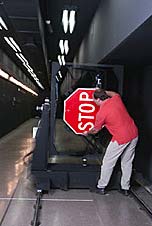New NIST Facility Soon Will Be ‘Reflecting’ on Safer Signs

© R. Rathe
Our roadways should get safer in the future, now that the National Institute of Standards and Technology (NIST) has developed a way to accurately and reliably measure how light reflects off stop signs and other road markings.
Road signs and markings are designed to be visible at night by retroreflectivity—that is, they reflect some of the light emitted by a vehicle’s headlights back toward the driver’s eyes. However, measurements of retroreflectivity have varied so much among different devices and laboratories that federal transportation officials have been unable to define minimum standards for this Congressionally mandated characteristic.
Recently, NIST established a facility—funded by the Transportation Research Board of the National Cooperative Research Program—that resolves numerous measurement problems and improves accuracy. Inside the facility, one finds a long black tunnel with a set of tracks on which sits an instrumented platform. Signs or materials are mounted on the platform, which can be moved 3 to 30 meters (10 to 100 feet) from a light source at one end of the tunnel. Using custom software, scientists precisely control all of the components and measure the characteristics of light reflected from the sign to a detector located close to the source.
NIST expects that the facility will begin providing calibration services early in 2004.
Media Contact
More Information:
http://www.nist.gov/public_affairs/techbeat/tb2003_0811.htm#signsAll latest news from the category: Transportation and Logistics
This field deals with all spatial and time-related activities involved in bridging the gap between goods and people, including their restructuring. This begins with the supplier and follows each stage of the operational value chain to product delivery and concludes with product disposal and recycling.
innovations-report provides informative reports and articles on such topics as traffic telematics, toll collection, traffic management systems, route planning, high-speed rail (Transrapid), traffic infrastructures, air safety, transport technologies, transport logistics, production logistics and mobility.
Newest articles

Bringing bio-inspired robots to life
Nebraska researcher Eric Markvicka gets NSF CAREER Award to pursue manufacture of novel materials for soft robotics and stretchable electronics. Engineers are increasingly eager to develop robots that mimic the…

Bella moths use poison to attract mates
Scientists are closer to finding out how. Pyrrolizidine alkaloids are as bitter and toxic as they are hard to pronounce. They’re produced by several different types of plants and are…

AI tool creates ‘synthetic’ images of cells
…for enhanced microscopy analysis. Observing individual cells through microscopes can reveal a range of important cell biological phenomena that frequently play a role in human diseases, but the process of…





















